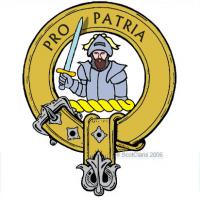
Clan Bannerman
Bannerman shares something with other Scottish names such as Armstrong and Turnbull in that it relates to an event in their history. Sometime during the late 11th and early 12th century, within the reign of either Malcolm III or Alexander I the Kings forces had assembled on the banks of the Spey where a rebel army had gathered on the other side. The Spey is a fast flowing river at the best of times and the rebels felt safe as the waters rose. The King was advised to wait until the river subsided before crossing to meet the rebel army. However the sight of the rebels so incensed the king that he took off into the river to meet them. The king's chamberlain, Sir Alexander Carron realised that the king was in danger and rode after him with the royal standard. on seeing the standard being carried across the river the rest of the Kings army followed across and defeated the rebels. As a reward for his quick thinking and bravery Sir Alexander Carron was made hereditary Standard Bearer to the King. His descendants still bear the privilege and carry the Scottish royal banner at appropriate ceremonies.
David II granted the Bannerman family the land of Clyntrees, Waterton and Welltown in 1367. The family was later granted land west of Aberdeen in 1370 by the Abbott of Kinloss.
Towards the end of the 16th Century the North East of Scotland was the scene for intense clan feuds between the Gordons and Forbes. The Bannermans were caught in the middle of this bitter conflict and at first took sides with Clan Forbes. However in 1608 Margaret Bannerman married George Gordon of Haddo son of Sir John Gordon. Sir John was a loyal supporter of King Charles I and was executed for opposing the National Covenant. Alexander Bannerman of Pitmedden also supported the King and almost lost his estates during the civil war. His fortunes improved in the restoration when Charles II named Sir Alexander Bannerman a Baronet of Nova Scotia for his loyalty in 1682. Alexander's son Patrick supported the Stuarts during the first Jacobite uprising, aligning himself with the 'Old Pretender' James Francis Edward Stuart. James VIII knighted Alexander in 1715 but his support for the Jacobites led him to be sentenced to death when the uprising failed. Fortunately he escaped to France.
Despite this the Bannermans supported the young pretender, Charles Edward Stewart when he arrived in Scotland. Sir Alexander, son of the second baronet joined the Jacobites at Stirling in 1745 with 160 men and stayed with the Prince till Culloden, fleeing after the battle he made his way north and then to France. In the climate that followed Sir Alexander Bannerman, fourth Baronet, was forced to sell the Elsick estates due to their jacobite connections. The estates were returned to the family in 1851 when Sir Alexander Bannerman, previously Governor of the Bahamas acquired them.
Sir Campbell Bannerman was the Liberal Prime Minister from 1905 to 1908. He was made Prime Minister in 1905 by Edward VII, after the resignation of Arthur Balfour. He was responsible for the appointments to the cabinet of Herbert Asquith and David Lloyd George two of the countries best known prime ministers. Asquith succeeded him in 1908 and he died just a few days later
John Bannerman was a legendary Rugby player and was capped for Scotland 39 times. He was made a life peer as Lord Bannerman of Kidonan in 1967 and died in 1969
The thirteenth Baronet served in the Cameron Highlanders. He became a Russian interpreter, and after his military career he taught at Gordonstoun and Fettes College in Edinburgh. His son is the present chief.




